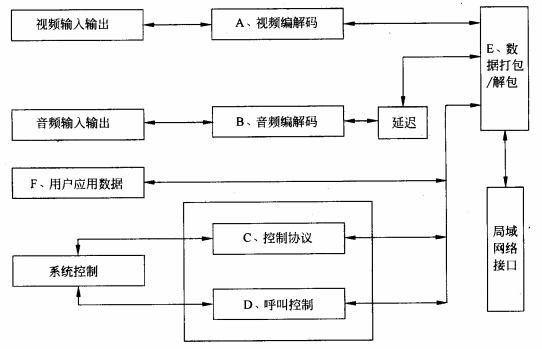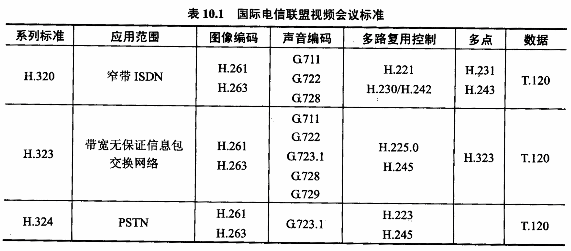阅读下列说明,回答问题1至问题3,将解答填入答题纸的对应栏内。【说明】H.323是ITU制定的在局域网上不保证QoS的多媒体通信标准。考查如下H.323标准的系统框图,回答问题1、2和3。

【问题1】在上图的A、B、C、D、E和F等模块中,协议H.263应用于系统框图的(1)模块,协议H.222位于系统框图的(2)模块,协议G728位于系统框图的(3)模块,协议Q.931位于系统框图的(4)模块。
【问题2】H.323视频会议系统适合ISDN等较高速网络,为了适应公用电话网络的低带宽要求,ITU发布了H.324视频会议标准,请说明H.323和H,324标准在协议选择上的主要区别。
【问题3】视频会议系统中呼叫控制的主要目的是什么?
参考答案:
【问题1】(1)A(2)E(3)B(4)D
【问题2】①H.323在视频编解码上选择了H.261和H.263,而H.324仅仅使用了H.263。②
H.323在音频编解码上选择了G711、G723等,而H.324仅仅使用了G723/730。
③H.323在复用上选择了H.222等,而H.324使用了H.223。
【问题3】①管理会议终端。②支持有效的QoS保证。
解析:
本题考查基于H.323协议的多媒体会议系统的基本内容。
多媒体会议系统是多媒体应用设计的一个全新的方向,它是包含未来会议的所有需求并形成视频、音频、图形一体化的解决方案。多媒体会议系统包括视频会议、音频会议、Web会议和即时信息,以及相关信息的即时存储和广播。
国际电信联盟制定的视频会议标准有H.320、H.323、H,324。如表10.1所示。
(1)H.320标准
H.320标准于20世纪90年代初开发,它定义通信的建立、数字电视图像和声音的压缩编码算法,运行在综合业务数字网(ISDN)上。
(2)H.323标准
H.323标准应用于局域网上的桌面电视会议,它是基于带宽无保证信息包交换的多媒体通信系统。H.323描述无QOS保证的LAN多媒体通信终端、设备和服务。其中视频选用H.261和H.263协议,音频选用G711、G722、G728、G.723等协议。复用采用H.222协议,控制采用H.245,呼叫控制采用Q.931协议。
(3)H.324标准在公众交换电话网(PSTN)上的桌面电视会议使用调制解调器,采用H.324标准。
H.324标准是针对极低速率通信网络的多媒体通信标准,所以在视频编解码中,H.324仅仅使用了H,263。在音频编解码中,H.324仅仅使用了G723/730协议。复用采用了H.223协议。

基于网络的多媒体会议系统目前大多趋于采用ITU-T的H.323标准和IETE的SIP标准,以前者使用最为广泛。在视频会议系统中,呼叫控制的主要目的是管理会议终端,支持有效的QoS保证。
